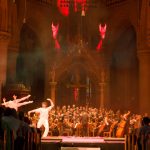Joseph Haydn composed “The Creation” between 1796 and 1798. The oratorio takes its theme from the creation of the world and is inspired by the biblical book of Genesis. This work was recently performed in the Cathedral of the Virgin Mary in Linz on the occasion of the New Cathedral’s 150th anniversary. Lighting designer Helmut Janacs used the Lightpower range for his rig, which included Clay Paky Alpha Spot HPE 700s and Clay Paky Alpha Spot HPE 1500s, among other lights.
Janacs explained: “I was familiar with Clay Paky Alpha Spot HPE 700s thanks to a detailed demonstration and advice from Lightpower Austria, and I knew they would be perfect for fitting at the sides 14 metres from the ground, exactly midway between the stage and the vaulted ceiling, owing to their size and easy handling. I am also spellbound by the Clay Paky Alpha Spot HPE 700’s brightness and its functions, such as the zoom, iris and number of gobos. They fit very well into the basic equipment too and are able to realize almost all creative ideas.”
“I also think the Clay Paky Alpha Spot HPE 1500s were excellent, especially if you consider we had to light an approximately 100 metre long vaulted cathedral ceiling,” the lighting designer continued. Janacs explained his lighting design: “What is more beautiful than an existing set, especially if we are talking about a cathedral? I immediately understood I would not have been able to realize my design ideas without moving lights. Furthermore, when the oratorio gets to the passage ‘And God said, Let there be light: and there was light’, I wanted to put it into practice with an ‘aha! experience’. It is a real challenge to try to represent the creation of the world, since it involves all the elements: water, the stars, the Earth, the Sun and animals. As far as I know, this is the first time this work has been performed in Upper Austria with the combination of an orchestra, choir, soloists and children’s ballet.”
Janacs concluded by praising the entire organization, including the artists and the Church, “because the highest priority was to avoid disturbing daily religious life and succeed in carrying out tests and technical monitoring. And it worked out beautifully.”
Fabrice Jucquois was the producer and general artistic director. Lightpower Austria provided the lighting and technical support.




